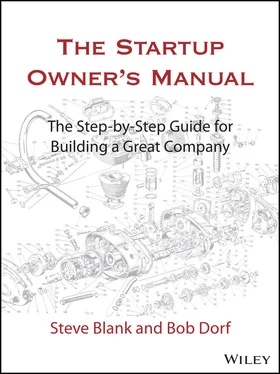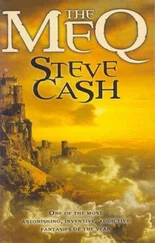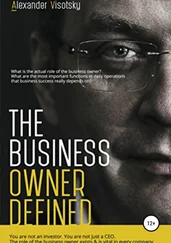The Startup Owner’s Manual™
The Step-by-Step Guide for Building a Great Company
Steve Blank and Bob Dorf

Copyright © 2020 by Steve Blank. All rights reserved.
The cover, design, and content are the same as the prior release and should not be considered a new or updated product.
Published by John Wiley & Sons, Inc., Hoboken, New Jersey.
Published simultaneously in Canada.
The Startup Owner’s Manualwas originally published by K&S Ranch Publishing Inc., K&S Ranch Publishing Division in 2012.
No part of this publication may be reproduced, stored in a retrieval system, or transmitted in any form or by any means, electronic, mechanical, photocopying, recording, scanning, or otherwise, except as permitted under Section 107 or 108 of the 1976 United States Copyright Act, without either the prior written permission of the Publisher, or authorization through payment of the appropriate per-copy fee to the Copyright Clearance Center, Inc., 222 Rosewood Drive, Danvers, MA 01923, (978) 750-8400, fax (978) 646-8600, or on the Web at www.copyright.com. Requests to the Publisher for permission should be addressed to the Permissions Department, John Wiley & Sons, Inc., 111 River Street, Hoboken, NJ 07030, (201) 748-6011, fax (201) 748-6008, or online at http://www.wiley.com/go/permissions.
Limit of Liability/Disclaimer of Warranty: While the publisher and author have used their best efforts in preparing this book, they make no representations or warranties with respect to the accuracy or completeness of the contents of this book and specifically disclaim any implied warranties of merchantability or fitness for a particular purpose. No warranty may be created or extended by sales representatives or written sales materials. The advice and strategies contained herein may not be suitable for your situation. You should consult with a professional where appropriate. Neither the publisher nor author shall be liable for any loss of profit or any other commercial damages, including but not limited to special, incidental, consequential, or other damages.
For general information on our other products and services or for technical support, please contact our Customer Care Department within the United States at (800) 762-2974, outside the United States at (317) 572-3993 or fax (317) 572-4002.
Wiley publishes in a variety of print and electronic formats and by print-on-demand. Some material included with standard print versions of this book may not be included in e-books or in print-on-demand. If this book refers to media such as a CD or DVD that is not included in the version you purchased, you may download this material at http://booksupport.wiley.com. For more information about Wiley products, visit www.wiley.com.
ISBN 9781119690689 (Hardcover)
ISBN 9781119690672 (ePDF)
ISBN 9781119690726 (ePub)
1 Cover
2 How to Read This Book How to Read This Book CLEARLY, THE STARTUP OWNER’S MANUAL IS not a novel. This book is a step-by-step how-to guide that details a process for building a successful, profitable, scalable startup. It has more in common with a car repair manual than it does with your favorite page-turner. Don’t attempt to read this book in a single sitting or long weekend. It will be your companion—and, we hope, your very best friend—for the six to 30 months or more that it often takes to begin building a successful, scalable startup business.
3 Preface
4 Who Is This Book For?
5 Introduction A Repeatable Path Why a Second Decade? The Four Steps: A New Path
6 I Getting Started Chapter 1: The Path to Disaster: A Startup Is Not a Small Version of a Big Company The Traditional New-Product Introduction Model The 9 Deadly Sins of the New Product Introduction Model Chapter 2: The Path to the Epiphany: The Customer Development Model An Introduction to Customer Development “The Search for a Business Model:” Steps, Iteration and Pivots A Customer Development Bonus: Minimum Waste of Cash and Time The Customer Development Manifesto Summary: The Customer Development Process Chapter 3: An Introduction to Customer Discovery The Customer Discovery Philosophy Chapter 4: Customer Discovery, Phase One: State Your Business Model Hypotheses Market Size Hypothesis (Physical and Web/Mobile) Value Proposition 1: “Low Fidelity” MVP Hypothesis (Web/Mobile) Customer Segments: Who/Problem Hypothesis (Physical) Customer Segments: Source/Wiring Hypothesis (Web/Mobile) Channels Hypothesis (Physical) Channels Hypothesis (Web/Mobile) Value Proposition 2: Market-Type and Competitive Hypothesis Customer Relationships Hypothesis (Web/Mobile) Key Resources Hypothesis (Physical and Web/Mobile) Partners Hypothesis (Physical) Traffic Partners Hypothesis (Web/Mobile) Revenue and Pricing Hypothesis Chapter 5: Customer Discovery, Phase Two: “Get Out of the Building” to Test the Problem: “Do People Care?” Design Tests and Pass/Fail Experiments Prepare for Customer Contacts (Physical) Build Your Low Fidelity MVP (Web/Mobile) Test Understanding of the Problem and Assess Its Importance (Physical) Avoid the Big-Company Meeting Trap Low Fidelity MVP Problem Test (Web/Mobile) Missteps to Avoid when Testing the Low Fidelity MVP: Gain Customer Understanding Capture Market Knowledge (Physical) Traffic/Competitive Analysis (Web/Mobile) Chapter 6: Customer Discovery, Phase Three: “Get Out of the Building” and Test the Product Solution Update the Business Model and Team (a Pivot-or-Proceed Point) Create the Product “Solution” Presentation (Physical) High Fidelity MVP Test (Web/Mobile) Test the Product Solution with the Customer (Physical) Measure Customer Behavior (Web/Mobile) Update the Business Model Again Identify First Advisory Board Members Chapter 7: Customer Discovery, Phase Four: Verify the Business Model and Pivot or Proceed Have We Found a Product/Market Fit? Do We Know Who Our Customers Are and How to Reach Them? Can We Make Money and Grow the Company? Pivot or Proceed? Chapter 8: Introduction to Customer Validation An Epiphany at E.piphany The Customer Validation Philosophy Overview of the Customer Validation Process Chapter 9: Customer Validation, Phase One: "Get Ready to Sell" Get Ready to Sell: Craft Positioning Statement Get Ready to Sell: Sales and Marketing Materials (Physical) Physical Sales Collateral and Materials Collateral Needs to Be Tuned to the Audience Online Tools for Physical Channel Marketers Get Ready to Sell: Acquire/Activate Customers Plan (Web/Mobile) The “Acquire” Plan and Tools Acquire Plan Tools The Activation Plan and Tools Non-home page acquisition tools Managing the Activate Plan Get Ready to Sell: Hire a Sales Closer (Physical) Get Ready to Sell: Build a High Fidelity MVP (Web/Mobile) Get Ready to Sell: Sales Channel Roadmap (Physical) Get Ready to Sell: Build a Metrics Toolset (Web/Mobile) Get Ready to Sell: Develop the Sales Roadmap (Physical) Get Ready to Sell: Hire a Data Analytics Chief (Web/Mobile) Get Ready to Sell: Formalize the Advisory Board (All Channels) Chapter 10: Customer Validation, Phase Two: Get Out of the Building and Sell! Get Out of the Building: Find Earlyvangelists (Physical) Get Out of the Building: Prepare Optimization Plans/Tools (Web/Mobile) Get Out of the Building and Test Sell (Physical) Get Out of the Building: Optimize Getting More Customers (Web/Mobile) Get Out of the Building: Refine the Sales Roadmap (Physical) Get Out of the Building: Optimize “Keep” and “Grow” (Web/Mobile) Get Out of the Building: Test Sell Channel Partners (Physical) Get Out of the Building: Test Sell Traffic Partners (Web/Mobile) Chapter 11: Customer Validation, Phase Three: Product Developing and Company Positioning No PR Agency The Positioning Audit Develop Positioning: Product Positioning The Product Positioning Brief Develop Positioning: Match Positioning to Market Type For an Existing Market For a New Market For a Clone Market For Re-Segmenting a Market Develop Positioning: Company Positioning Develop Positioning: Validate Positioning Chapter 12: Customer Validation, Phase Four: The Toughest Question of All: Pivot or Proceed? Pivot or Proceed: Assemble Data Findings Pivot or Proceed: Validate Your Business Model Pivot or Proceed: Validate the Financial Model Metrics that Matter Metrics that Matter: Example 2 If These Were Your Numbers, What’s a Founder to Do? Metrics that Matter: Example 3 Pivot or Proceed: Re -Validate the Business Model The Toughest Startup Question: Pivot or Proceed?
Читать дальше












